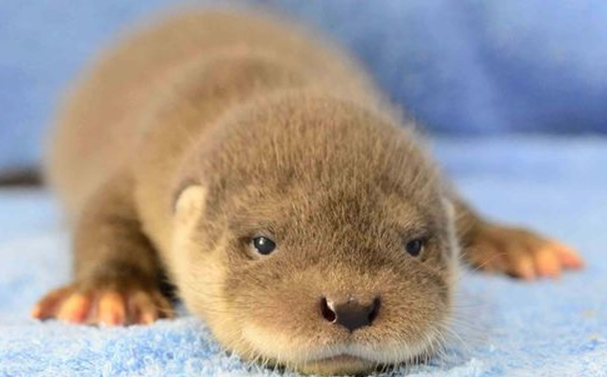雅思阅读真题重点推荐:Otters水獭
今天要分享的是一篇关于Otters水獭的雅思阅读原文,分别在2013年和2010年考过,内容同样来自新航道《9分达人雅思阅读真题还原及解析3》←下载。
查看更多,请:雅思阅读真题回忆,近期的雅思阅读考试重点也在其中哦!
READING PASSAGE 1
You should spend about 20 minutes on Questions 1-13, which are based on Reading Passage 1 below.
Otters水獭

A)Otters are scmiaqualic (or in the case of the sea otter, aquatic) monirnals. rHiey ure mi'inbers of the Mustelid family which includes badgers, polecats, martens, weasels, stoats an have inluibited the earth for the last 30 million years and over the years have undergone subtle changes to the carnivore bodies to exploit the rich aquatic environment. Otters have long liiin body and short legs~ideal for pushing dense undergrowth or hunting in tunnels. An adult male may be up to 4 feet long and 30 pounds. Females are smaller, around 16 pounds typically. The Eurasian otter nose is about ihc smallest among the otter species and has a characteristic shape described as a shidlow "W".An otter's tail (or rudder, or stern) is stoul at tlie base and tapers towards the tip where il flattens. ITiis forms part of the propulsion unit when swimming fast under water. Oder fur consists of iwo types of hair: stout guard hairs which form a waterproof outer covering, and undcrfiir which is dense and fine,equivalent to an otter's thermal underwear. The fur must he kept in good condition by grooming. Sea water reduces the waterproofing and insulating qualities of otter fur when salt water gets in the fur. This is why freshwater pools are important to otters living on the coast. After swimming, they wash the salts ofT in the pools and then squirm on the ground to rub dry against vegetation.
B) Scent is used for hunting on land, for communication and for detecting danger. Otterine sense of smell is likely to similar in sensitivity to dogs. Otters have small eyes and arc probably short-siglited on land. Bui they do have the ability to modify the shape of the lens in the eye to make it more spherical, and hence overcome the refraction of water In clear water and good liglit, otters can hunt fish by sight. The otter's eyes and nostrils are placed high on its head so that it c-an see and breulhc oven when the rest of die body is submerg'd, "The long whiskers growing iinmnd the muzzle are used to detect the presence of fish. They detect regular vihrutions cruised by the beat of the fish's tail as it swims awuy. I'his tdlows otters to hunt even in very murky water. Underwater, the otter holds its legs against the body, except for steering, and the hind end of the body is flexed in a series of vertical undulations. River otters have webbing which extends for much of the length of each digit, though not lo the very end. Giant otters ami sea otters have even more prominent webs, while the Asian short-clawed otter lias no webbing-they hunt for shrimps in ditches and paddy fields so they need the swimming speed. Otter ears are protected by valves which close them against water pressure.
C A number of constraints and preferences limit suitable liabitats for otters. Water is a must and the rivers must be large enough to support a healthy population of fish. Being such shy and wary creatures. they will prefer territories where mail's activities do nol impinge grcally. Of course, there must also be no other otter already in residence-this has only become significant again recently as populalions start to recover. A typical range for a mule river otter might he 25km of river, a female's range loss than half this. I lowcver, ihc pnMluclivity of the river affecls ihis hugely and one sitidy found male ranges between 12 and 80km. Coastal oilers havr a mucli more abundant Uwd supply aiul ranges for males and females may be just a few kilometers of coastline. Because male ranges are usually larger, a male otter may find his range overlaps with two or three females. Otters will eat anytliing that they can get hold of there are records of sparrows and snakes and slugs gobbled. Apart from fish the most common prey are crayfish, oralis and water birds. Small munmmls are occasionally taken, most mmmonly rabbits but soinelimes even moles.
D )Eurasian otters will bretnJ any time where food is readily available. In places where condition is more severe, Sweden for example where the lakes are frozen for much of winter, cubs arc bom in Spring, This ensures that they are wdl grown before severe weather returns. In the Shetlands. cubs are bam in summer when fish is more abundant. Though otters can breed every year, some do not. Again, this depends on food availability. Other factors such as food range and quality of the female muy have an effect. Gestation for Eurasian otter is 63 days, with the exception of North American river otter whose embryos may undergo delayed implantation.
E )Otters normally give birth in more secure dens to avoid disturbances. Nests are linceing the most common). For some unknown reason, a^astal otters lend to produce smaller litters. At five weeks they open their eyes~a liny cub of 700g. At seven weeks they're weaned onto solid food. At five weeks they leave the nest, blinking into daylight for the first time. After three months they finally meet the water and learn to swim. After eight months they are hunting, though the mother still provides a lot of food herself. Finally, after nine months she ttan chase them all away with a clear conscience, and relax-until the next fella shows up.
F) The plight of the British oiler was recognised in the early 60s,but it wasn^t until the late 70s that ihe chief cause was discovered. Pcslicides. such as diddrin and aldriiu were first used in 1955 in iigriculture and other industries--these clicmiads are very persistenl and liad already been recognised as the muse of huge declines in the population of ficregrinc falcons, sparrowhawks and oilier predators. The pesticides entered the river systems and the food chain-micro-organisms. fish and finally otters, with every step increasing ihc concentration of the chemicals. From 1962 the chemicals were phased out, but while some species recovered quickly, otter numbers did not and continued to fall into the 80s/niis was probably mainly to habitat destruction and road deaths. Acting on popuIations fragmented by the sudden decimalion in the 50s and 60s, the loss of just a handful of otters in one area can make an entire population unviable and spoil the end.
G )Otter numkiers anr recovering all around Britain--populations arc growing again in the few areas where they had remained and have expanded from those areas into the rest of the country. This is almost entirely due to law and conservation efforts, slowing down and reversing the destruction of suitable otter habitat and reintroductions from captive breeding programs. Releasing captive-bred otters is seen by many as a last resort, The argument runs that where there is no suitable habitat for them they will not survive after release and when there is suitable habitat, natural populations should be able lo expand inlo the area. However, reintroducing animals into a fragmented and fragile population may add just enough im|petus for it to stabilise and expand, rather than die out. This is what the Otter Trust accomplished the 1980s. The Otter Trust has now finished its captive breeding program entirely. Great news because it means it is no longer needed.
题目:
Questions 1-9 Reading Passage 1 has seven paragraphs, A-G.
Which paragraph contains the following information?
Write the correct letter, A-G, in boxes 1-9 on your answer sheet.
NB You may use any letter more than once.
1 A description of how otters regulate vision underwater
2 The fit-for-purpose characteristics of otter's body shape
3 A reference to an underdeveloped sense
4 An explanation of why agriculture failed in otter conservation efforts
5 A description of some of the otter’s social characteristics
6 A description of how baby otters grow
7 The conflicted opinions on how to preserve
8 A reference to a legislative act
9 An explanation of how otters compensate for heat loss
Questions 10-13
Answer the questions below.
Choose NO MORE THAN TWO WORDS from the passage for each answer.
Write your answers in boxes 10-13 on your answer sheet
10 What affects the outer fur of otters?
11 What skill is not necessary for Asian short-clawed otters?
12 Which type of otters has the shortest range?
13 Which type of animals do otters hunt occasionally?







